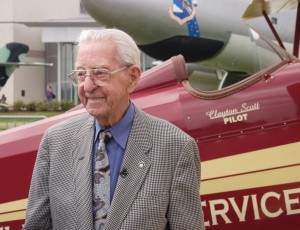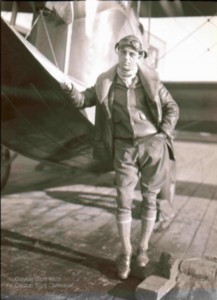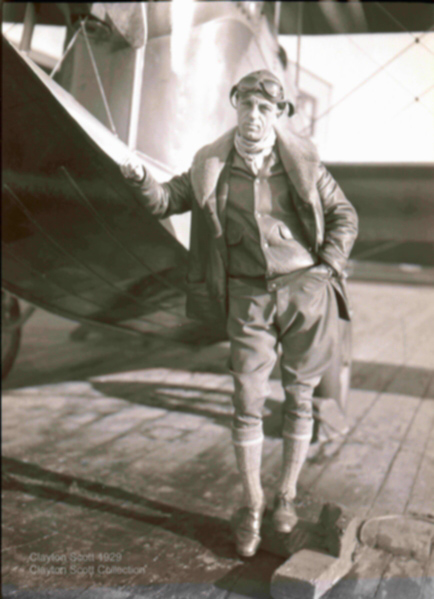By Terry Stephens

Clayton Scott poses with this 1928 Travel Air biplane at The Museum of Flight in July 2005, during his 100th birthday celebration.
When Pacific Northwest aviation legend Clayton L. “Scotty” Scott, 101, died from a heart attack Sept. 28, he was still spry and energetic. His last flight as a pilot was in 2005, to celebrate his 100th birthday. His 79-year flying career included biplanes, airliners and jet bombers.
Perhaps his most memorable flight was across the Gulf of Alaska, from Ketchikan to Cordova, in 1930; it was the first crossing by a commercial transport. One of the passengers was Myrtle Smith, a schoolteacher who married Scott in 1934, and was his wife for 65 years, until her death in 1998. Scott’s death at 101 was in the apartment they shared in their senior years in Mercer Island, east of Seattle.
After learning to fly in 1926, Scott became an airmail pilot, Bill Boeing’s personal pilot, a test pilot for Boeing bombers and airliners and an owner of his own floatplane business at Renton Municipal Airport (RNT). Although he quit flying solo when he was 98, he continued to go aloft with a copilot, even flying a twin-engine Piper Aerostar to Boeing Field in 2005 for his 100th birthday celebration at The Museum of Flight. The event, attended by scores of friends and dignitaries from the aviation world, celebrated the christening of RNT as Clayton Scott Field.
At the celebration, Douglas Murphy, Pacific Northwest administrator for the Federal Aviation Administration, presented Scott with the Wright Brothers Master Pilot award. The honor is reserved for aviators who have “demonstrated exceptional competence and commitment to excellence by logging 50 or more consecutive years of safe flight.” Murphy noted during the ceremony that Scott’s pilot’s license, # 2155, made him America’s oldest active pilot.
When Scott turned 101 in July, the city of Renton threw a birthday party for him at the municipal airport now bearing his name. A brass statue of Scott as a young pilot was unveiled. Dubbed “Pathfinder,” the monument will soon be installed at the entrance to the airport.
The tribute honored Scott for his pioneering flying career and long-time association with the airport since 1928. When the new entrance to the airport is finished, it will include Pathfinder Park, featuring Scott’s impressive statue, showing him in the helmet, goggles and leather-jacket he wore in the 1920s and 1930s. Next to him is a 16-foot pole with direction signs in the shape of propellers, pointing to destinations around the world.

Pacific Northwest pioneer aviator Clayton Scott, who died at his Mercer Island home Sept. 28 at the age of 101, had a 79-year flying career. Renton Municipal Airport was renamed in his honor as Clayton Scott Field.
Born in 1905, Scott first became interested in flying when a barnstormer set his Curtiss Jenny down on his uncle’s Pennsylvania farm. Rides were offered, but the 15-year-old didn’t get to fly at that time. But, in 1922, after his family had moved to Oregon, Scott went aloft with a barnstormer flying into Seaside. He never forgot that exhilarating experience.
Four years later, employed by Pacific Air Transport as a station manager at Pearson Field in Vancouver, Wash., Scott began taking flying lessons from airmail pilots. He soloed in a Waco after less than four hours of instruction.
By February 1927, he had earned his commercial license and was flying mail for Pacific Air Transport. When William Boeing bought the company in 1928 and made it a division of Boeing Air Transport, Scott moved to Seattle as operations manager for Gorst Air Transport, which included the Seattle Flying Service and the Bremerton Air Ferry.
While flying a 1917 Travel Air biplane, bad weather forced him down on the most likely landing real estate around—the yet unopened Boeing Field (today’s King County International Airport). Since then, Scott is remembered as the first pilot to land and take off from the airfield.
Scott first met William Boeing in 1931, at a gas pump in Carter Bay, British Columbia. Scott was fueling his Keystone-Loening Air Yacht while Boeing was refueling his twin-screw diesel yacht, the Taconite, built by Boeing Aircraft of Canada in 1929. After that chance meeting, the two men became lifelong friends. In 1931, Boeing hired Scott as his personal pilot. He later employed him as The Boeing Company’s chief production test pilot. Scott held that role for 25 years, until he retired in 1966.
During those years, Scott flew most of the planes Boeing built, including the B-17, B-29, B-47 and B-52, which he called “the Cadillac of Boeing planes.” He also flight-tested Boeing’s 707 airliner and the models that followed, until the mid-1960s.
After retiring in 1966, Scott worked fulltime in his own business, Jobmaster Inc. He started the company in 1954, at the Renton airfield, to adapt floats to fit a wide variety of aircraft.
As a pioneering aviator, test pilot and intrepid flyer, Scott has received many honors from scores of organizations, including the Federal Aviation Administration, Experimental Aircraft Association, National Aeronautic Association, the OX5 Aviation Pioneers, Aircraft Owners and Pilots Association, Quiet Birdmen and the Society of Experimental Test Pilots.
See Also: Renton Airport Monument Honors Pioneer Aviator Clayton Scott











